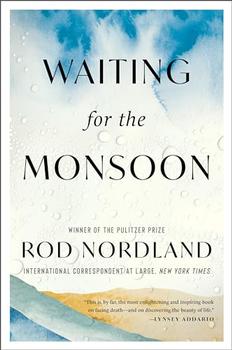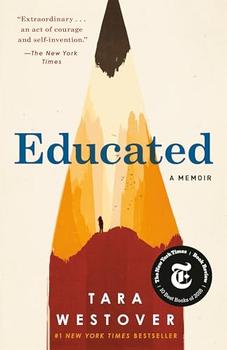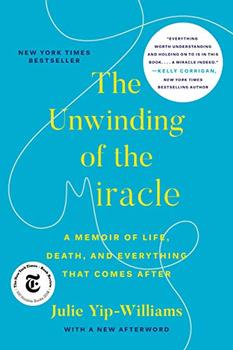Summary | Excerpt | Reviews | Beyond the book | Read-Alikes | Genres & Themes | Author Bio

The title of Rod Nordland's autobiography could be a metaphor for the death he knows is coming for him after a stage 4 glioblastoma diagnosis, or for any of the many crises he has faced in his eventful life as a foreign correspondent for the Philadelphia Inquirer, Newsweek, and the New York Times. But it's also literal: in July 2019, he was reporting in India just before its rainy season began. A bystander found him suffering from a grand mal seizure and hailed an ambulance. At the hospital, doctors discovered a brain tumor and he was medevacked to New York City's Weill Cornell Medical Center for surgery, which took place on his 70th birthday. Afterwards, his surgeon was frank, telling Nordland he might get 15 more months, but that brain cancer would kill him eventually. "Waiting for the Monsoon" was the title he gave to the journal, and then the New York Times article, he wrote about his experience.
Nordland has already outlived his surgeon's prognosis by more than three years, taking advantage of what he calls his "Second Life" to cultivate gratitude and healthy habits, and, of course, to write Waiting for the Monsoon (see Beyond the Book for more terminal illness memoirs). Frustrated to no longer be able to travel to conflict zones, he nevertheless describes writing as an "adventure of the mind." The book is structured into two long sections, with Part I, "Before the Monsoon," chronicling life up until the seizure. Though not expansive about his personal life, he acknowledges that busyness and distance led to his divorce, and estrangement from his children. Cancer brought his ex-wife and kids back to his bedside, however – along with his current partner.
"If there was ever a life designed to teach one how to face death, mine was it," Nordland writes, referring to both his difficult childhood and his perilous travels as a journalist. Growing up in poverty with a physically abusive father encouraged self-sufficiency. After his battered mother left his father for good, the author was the "man of the house"; he worked starting at 13, contributing money from his several jobs (and what he stole), but there was never enough food for him and his five siblings. Only much later did he realize that his father was a serial pedophile, finally convicted in 1994 to spend the rest of his life in prison.
After a period of juvenile probation resulting from his petty crime record, Nordland cleaned up his act and enrolled in college. Initially, he studied biochemistry with the (ironic) goal of curing cancer. However, he got into journalism via the student newspaper and decided he would instead work to expose injustice. His upbringing had given him a keen sense of right and wrong, and compassion for the exploited. He also posits that it inured him to the worst of what he would encounter in war zones.
Much of the book is given over to stories from the field. Nordland's first journalistic trip abroad was to Rome for a pope changeover, but after that he was generally sent to sites of conflict and tragedy, including parts of Central America, Africa, and especially Asia. Interspersed with the narrative are reprinted articles he filed from overseas: East Timor in 1982, Bosnia in 1996, and so on. After 9/11, Afghanistan was a frequent destination and a place for which he felt a particular burden – he writes movingly of the plight of women in its violent, macho culture. Threat was everywhere, from radiation at Three Mile Island to a lioness wandering into camp in Zimbabwe. Nordland thrived on excitement, and conveys the thrill and danger to readers.
Part II, "After the Monsoon," marks an inevitable change of pace as the author considers the setbacks of the past few years. Post-surgery, he has had continued seizures, loss of sensation, and memory issues – so to have remembered his career in such detail is remarkable. He composed most of this book by touch-typing, but parts were written via dictation and transcribed by his two assistants. It is a straightforward, chronological life story, illustrated with black-and-white photographs. Towards the end, the chapter topics start to seem a little scattershot. There is even a subtle self-help angle, as he got into the habit of asking everyone, from his nurses to a call center representative, about their thoughts on the meaning of life. I was also intrigued by the fact that Nordland converted to Judaism in his seventies after having been a lifelong atheist. He found that its brand of spirituality was open to questioners. Overall, I was more interested in his upbringing and cancer journey than in his wartime experience, but others will feel differently. By virtually anyone's standards, though, he has lived a fascinating life, full of hardship but consistently hopeful.
![]() This review was originally published in The BookBrowse Review in March 2024, and has been updated for the
April 2025 edition.
Click here to go to this issue.
This review was originally published in The BookBrowse Review in March 2024, and has been updated for the
April 2025 edition.
Click here to go to this issue.

If you liked Waiting for the Monsoon, try these:

by Tara Westover
Published 2022
Winner of the 2018 BookBrowse Nonfiction Award
An unforgettable memoir about a young girl who, kept out of school, leaves her survivalist family and goes on to earn a PhD from Cambridge University.

by Julie Yip-Williams
Published 2020
As a young mother facing a terminal diagnosis, Julie Yip-Williams began to write her story, a story like no other. What began as the chronicle of an imminent and early death became something much more - a powerful exhortation to the living.
Courage - a perfect sensibility of the measure of danger, and a mental willingness to endure it.
Click Here to find out who said this, as well as discovering other famous literary quotes!
Your guide toexceptional books
BookBrowse seeks out and recommends the best in contemporary fiction and nonfiction—books that not only engage and entertain but also deepen our understanding of ourselves and the world around us.